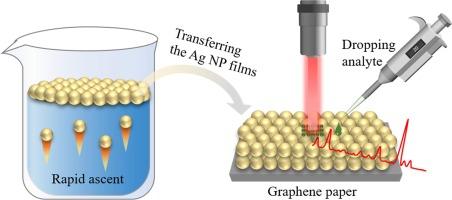Uniformly aligned Ag NPs/graphene paper for enhanced SERS detection of pesticide residue
IF 4.6
2区 化学
Q1 SPECTROSCOPY
Spectrochimica Acta Part A: Molecular and Biomolecular Spectroscopy
Pub Date : 2024-12-01
DOI:10.1016/j.saa.2024.125535
引用次数: 0
Abstract
The surface-enhanced Raman scattering (SERS) technique provides a quick and reliable method for detecting pesticide residues. In this study, flexible substrates, composed of orderly arranged silver nanospheres (Ag NPs) films on graphene paper, were fabricated through a simple, low-cost Ag NP self-assembly process at a liquid–liquid interface, followed by transfer of the films onto the graphene paper. The SERS performance of the fabricated substrates was evaluated using a portable Raman spectrometer, with rhodamine 6G (R6G) serving as the probe molecule. The results indicate that the bilayer Ag NP films-covered graphene paper exhibits optimal overall performance, characterized by high sensitivity and high uniformity. The limit of detection (LOD) for the R6G molecule is as low as 8.73 × 10−9 M, demonstrating the strong signal amplification capability of the SERS substrate. Moreover, the relative standard deviation (RSD) of the Raman intensity at 1508 cm−1 for different selected points on the substrate is 5.018 %, indicating high uniformity of the SERS substrate. Finally, the performance of the SERS substrate was further evaluated by detecting thiram in fresh orange juice, demonstrating the capability to detect concentrations as low as 10−6 M. This result highlights the significant potential of the developed SERS substrate for practical applications in food safety and quality control.

均匀排列银纳米粒子/石墨烯纸增强SERS检测农药残留。
表面增强拉曼散射(SERS)技术为农药残留检测提供了一种快速、可靠的方法。在这项研究中,通过一种简单、低成本的银纳米球(Ag NPs)自组装工艺,在石墨烯纸上制备了由有序排列的银纳米球(Ag NPs)薄膜组成的柔性衬底,然后将薄膜转移到石墨烯纸上。以罗丹明6G (R6G)作为探针分子,利用便携式拉曼光谱仪对制备的底物进行SERS性能评价。结果表明,双层银NP膜覆盖的石墨烯纸具有高灵敏度和高均匀性的最佳综合性能。对R6G分子的检出限(LOD)低至8.73 × 10-9 M,表明SERS底物具有较强的信号放大能力。在1508 cm-1处,基底上不同点的拉曼强度的相对标准偏差(RSD)为5.018%,表明SERS基底具有较高的均匀性。最后,通过检测鲜橙汁中的硫胺,进一步评估了SERS底物的性能,证明了其检测浓度低至10-6 m的能力。这一结果凸显了所开发的SERS底物在食品安全和质量控制方面的实际应用潜力。
本文章由计算机程序翻译,如有差异,请以英文原文为准。
求助全文
约1分钟内获得全文
求助全文
来源期刊
CiteScore
8.40
自引率
11.40%
发文量
1364
审稿时长
40 days
期刊介绍:
Spectrochimica Acta, Part A: Molecular and Biomolecular Spectroscopy (SAA) is an interdisciplinary journal which spans from basic to applied aspects of optical spectroscopy in chemistry, medicine, biology, and materials science.
The journal publishes original scientific papers that feature high-quality spectroscopic data and analysis. From the broad range of optical spectroscopies, the emphasis is on electronic, vibrational or rotational spectra of molecules, rather than on spectroscopy based on magnetic moments.
Criteria for publication in SAA are novelty, uniqueness, and outstanding quality. Routine applications of spectroscopic techniques and computational methods are not appropriate.
Topics of particular interest of Spectrochimica Acta Part A include, but are not limited to:
Spectroscopy and dynamics of bioanalytical, biomedical, environmental, and atmospheric sciences,
Novel experimental techniques or instrumentation for molecular spectroscopy,
Novel theoretical and computational methods,
Novel applications in photochemistry and photobiology,
Novel interpretational approaches as well as advances in data analysis based on electronic or vibrational spectroscopy.

 求助内容:
求助内容: 应助结果提醒方式:
应助结果提醒方式:


